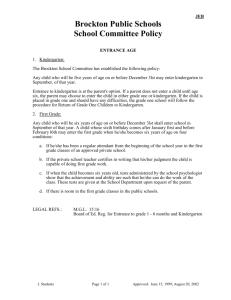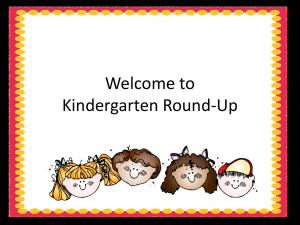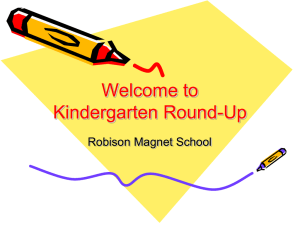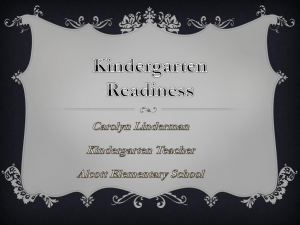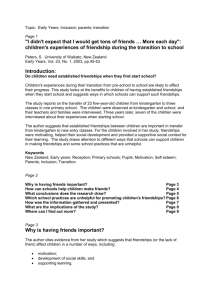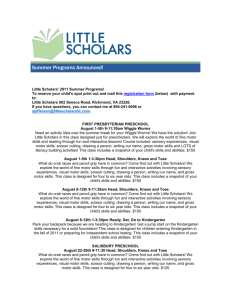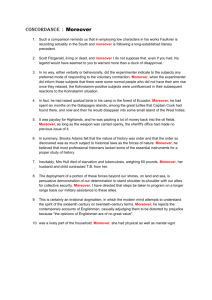School Age Observation - Amy Fleck Education Portfolio
advertisement
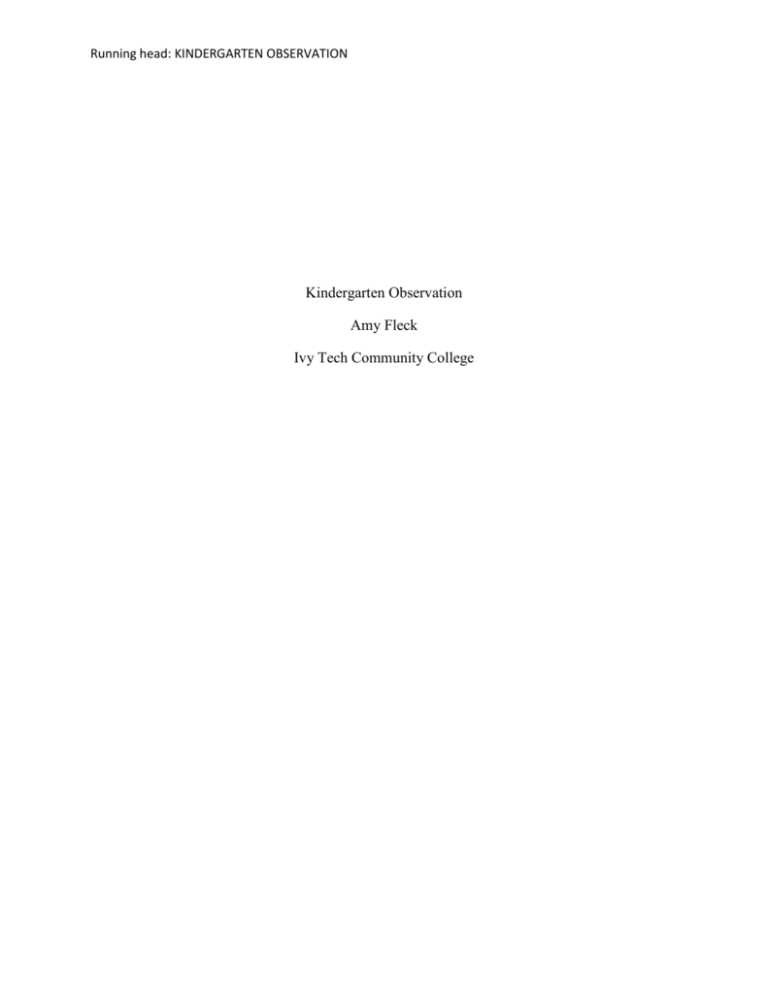
Running head: KINDERGARTEN OBSERVATION Kindergarten Observation Amy Fleck Ivy Tech Community College KINDERGARTEN OBSERVATION 2 INTASC Standard, Description and Rationale Standard #5, Classroom Motivation and Management Skills The teacher uses an understanding of individual and group motivation and behavior to create a learning environment that encourages positive social interactions, active engagement in learning, and self-motivation. Name of Artifact: School Age Observation Date: April 6, 2014 Course: EDUC 121 Brief Description: For this assignment, I observed a group of kindergarten students in their classroom. While there, I paid particular attention to both their fine and large motor skills as well as how they cooperated in groups large and small. Within this summary of my observations, I also detail how the teacher in the room interacts with her students to create an environment that is both safe and educational. Rationale: To document my understanding of Standard #5, classroom management and motivation, I selected to include my school age observation because this assignment helped me to understand how a school age teacher can create the appropriate learning environment within his or her classroom. Moreover, this assignment taught me how to deal with conflicts between students and how to assess each student’s personal traits to give them the best educational experience possible. KINDERGARTEN OBSERVATION 3 Introduction For this observation, I watched an extremely small class of kindergarteners with seven children, all aged six years old. During my sessions visiting the classroom, I examined the children’s fine and large motor skills, how they interacted as a group, friendships that were developing, and other important features. Moreover, I also spent a considerable amount of time observing the students’ teacher to discover how she was able to manage this group of children while still creating a welcoming, learning environment. Large and Small Motor Skills Unlike many of the other small children I have observed, the children in the kindergarten class had much more control over their bodies while participating in large and small motor functions. Children in this group were all able to eat their food using exclusively their sporks, zip up their coats, button their pants or shirts, write their own name and the letters of the alphabet, cut using scissors, build towers with large and small blocks, catch a small bouncy ball, run, jump, gallop, skip, kick a ball, and climb a ladder. This rapid growth in a child’s motor skills I have noticed will continue to increase with age, experience, and practice. I believe the ability demonstrated by the older children shows that they each have had extensive practice in finetuning their skills. Industry It is thought that school age children develop mentally to become more industrious. In simple terms, industry is in children is said, “to bring a productive situation to completion” as well as having the downside of making the child a “conformist and thoughtless slave whom others exploit” (Davis and Clifton). This theory is proved by some of the observations I saw personally during my time with the class. One such observation took place while the children KINDERGARTEN OBSERVATION 4 were building with blocks. As younger students, children tend to make simple structures; however, during my observation, the school aged kids made intricate structures with rooms, roads, and even furniture. Unfortunately, many of these children can also be easily manipulated by their classmates or older siblings because they have learned to please others while ignoring their own wants. Group Activities Both inside and outside, children in this group were very egotistical and quick to judge the other student’s actions. While inside participating on schoolwork and social activities, the children were able to acknowledge that others had ideas but insisted that their own ideas were the best. Often, this belief caused friction between all members of the group which required teacher intervention to smooth over. While outside, we played amoeba tag with another class from the school. The children that I was observing were able to listen to the rules but were quick to complain when one child broke or even seemed to break the rules. Moreover, the longer the game continued (we were outside for a little more than a half an hour playing this game) the less able the children seemed to be able to follow the rules. Lastly, since the faster children were able to tag the slower children this left these two different ability students as a pair. Although we explicitly told the students at the beginning of the game they were not to pull on the other children’s arms, the faster students seemed to instantly forget this rule as soon as they became paired. Rule Enforcement Although the children knew the rules, there were some who tried to push the limits of each rule to find what they could get away with. Because of this, the students were apt to correct or point out other students mistakes in some situations while in others, the teacher needed to KINDERGARTEN OBSERVATION 5 intervene. Some tasks, such as to where the centers were to stay on the table and how many scrap pieces of paper they were allowed to use during the day, were very well monitored by the students themselves. Tasks such as who was actually following the rules correctly when disagreements occurred or whose ideas were the best often had to be supervised by the teachers. Even though the teacher solved disagreements about the rules multiple times throughout the day, I believe the students did a very good job of this as well considering their age. Friendships From the time we are very young, friendships are constantly developing and being redefined. Within this small class, I think many of the friendships are formed by a mutual like in something such as a movie or toy. Moreover, I noticed that the friendships seemed to grow when the children lived close together and were able to play together outside of school. Teacher/Student Values While each of the students knows his or her place within the classroom, I believe the teacher has done a great job in helping the students to find what values should matter to each of them. Whereas honesty is highly valued so are both knowledge and leadership. The students trust that the teacher will provide them information that they themselves have learned. Moreover, the students know the teacher is not only there to help them learn facts, but also how to present themselves appropriately. The students each value their freedom within the classroom as the teacher tries not to involve herself in disputes if it is thought that the students can handle the issue themselves. KINDERGARTEN OBSERVATION 6 References Davis, D., & Clifton, A. (n.d.). Erikson’s Stages. Retrieved from http://www.haverford.edu/psych/ddavis/p109g/erikson.stages.html


